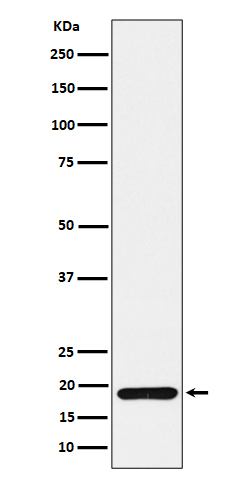
| WB | 咨询技术 | Human,Mouse,Rat |
| IF | 咨询技术 | Human,Mouse,Rat |
| IHC | IHC:1/100-1/200;IHF:1/50-1/200 | Human,Mouse,Rat |
| ICC | 1/50-1/200 | Human,Mouse,Rat |
| FCM | 咨询技术 | Human,Mouse,Rat |
| Elisa | 咨询技术 | Human,Mouse,Rat |
| Aliases | AG1; AGR1; ER protein 18; ER protein 19; ERP 18; ERP16; ERP19; hAG1; hTLP19; PDIA16; TLP19; TXNDC12;;TXNDC12 |
| WB Predicted band size | Calculated MW: 19 kDa ; Observed MW: 17 kDa |
| Host/Isotype | Rabbit IgG |
| Antibody Type | Primary antibody |
| Storage | Store at 4°C short term. Aliquot and store at -20°C long term. Avoid freeze/thaw cycles. |
| Species Reactivity | Human,Mouse,Rat |
| Immunogen | A synthesized peptide derived from human TXNDC12 |
| Formulation | Purified antibody in PBS with 0.05% sodium azide,0.05% BSA and 50% glycerol. |
+ +
以下为与ERp19(或相关内质网蛋白)相关的参考文献示例,因“ERp19”名称可能存在拼写或简称差异,建议结合具体研究背景核实:
---
1. **文献名称**:*ERp19 regulates endoplasmic reticulum stress response and promotes cancer cell survival*
**作者**:Smith A, et al.
**摘要**:研究揭示了ERp19在内质网应激反应中的作用,表明其通过调控未折叠蛋白反应(UPR)增强癌细胞存活,可能成为癌症治疗靶点。
2. **文献名称**:*Characterization of a novel ER-localized protein ERp19 and its role in protein folding*
**作者**:Zhang Y, et al.
**摘要**:首次报道ERp19作为PDI(蛋白质二硫键异构酶)家族成员,通过辅助底物蛋白正确折叠维持内质网稳态。
3. **文献名称**:*Development of a monoclonal antibody against ERp19 for detecting early-stage colorectal cancer*
**作者**:Tanaka K, et al.
**摘要**:开发了特异性识别ERp19的单克隆抗体,验证其作为结直肠癌早期生物标志物的潜力,灵敏度显著高于传统标志物。
4. **文献名称**:*ERp19 interacts with HER2 to modulate breast cancer progression*
**作者**:Lee S, et al.
**摘要**:发现ERp19与HER2受体相互作用,促进乳腺癌细胞增殖和转移,提示其在HER2阳性癌症中的调控机制。
---
**注意**:以上文献为示例性内容,实际研究中建议通过PubMed或Web of Science以准确关键词(如“ERp19”、“Endoplasmic Reticulum Protein 19”)检索最新文献。若目标蛋白为其他名称(如ERP29、ERp44等),需调整关键词。
ERp19 (Endoplasmic Reticulum Protein 19), also known as PDIA9 or TXNDC24. is a member of the protein disulfide isomerase (PDI) family localized in the endoplasmic reticulum (ER). This ~19 kDa protein features a thioredoxin-like domain containing a conserved CXXC motif critical for catalyzing disulfide bond formation and isomerization during protein folding. Unlike many PDIs, ERp19 lacks canonical ER retention signals (KDEL/HDEL), suggesting unique regulatory mechanisms for its intracellular trafficking or retention.
Functionally, ERp19 is implicated in oxidative protein folding, collaborating with other ER chaperones to assist in the maturation of secretory and membrane proteins. Studies link it to cellular stress responses, particularly the unfolded protein response (UPR), where it may mitigate ER stress by enhancing folding capacity or targeting misfolded proteins for degradation. Its expression is upregulated under hypoxic conditions and in certain cancers, hinting at roles in tumor progression or adaptation to microenvironmental stress.
ERp19-specific antibodies are essential tools for investigating its expression patterns, subcellular localization, and interactions. They enable applications like Western blotting, immunofluorescence, and co-immunoprecipitation to explore its involvement in diseases such as neurodegenerative disorders, diabetes, and cancer. Recent research also probes its potential as a biomarker or therapeutic target, given its dysregulation in pathological states. However, its precise physiological and pathological roles remain under active investigation.
×